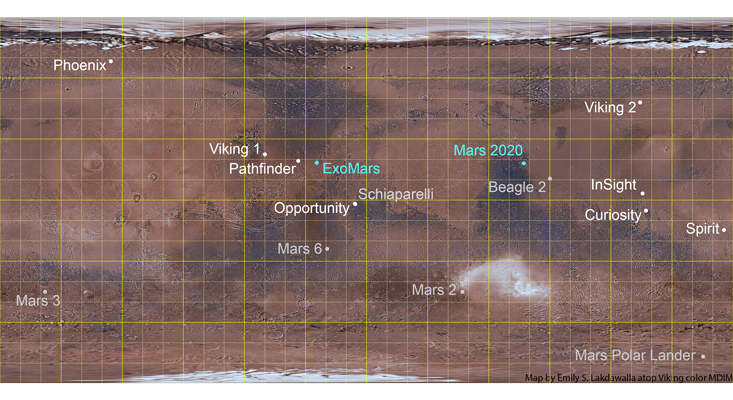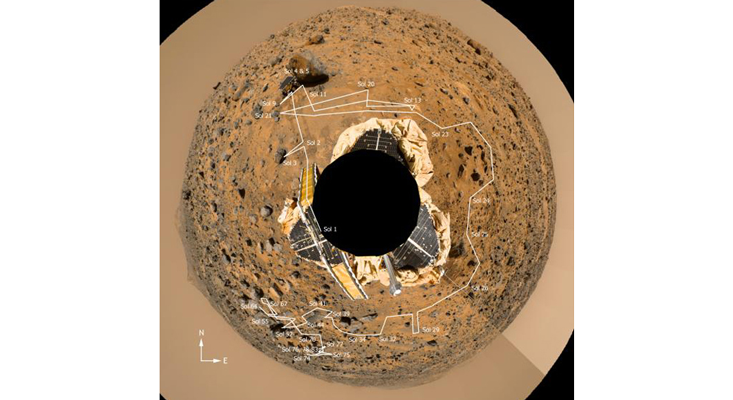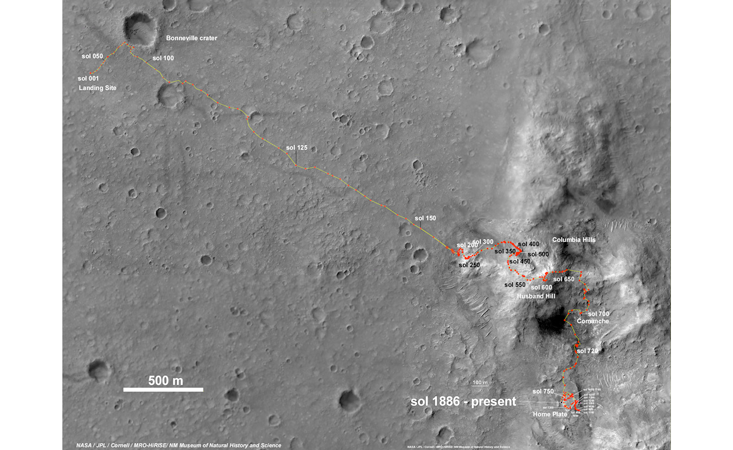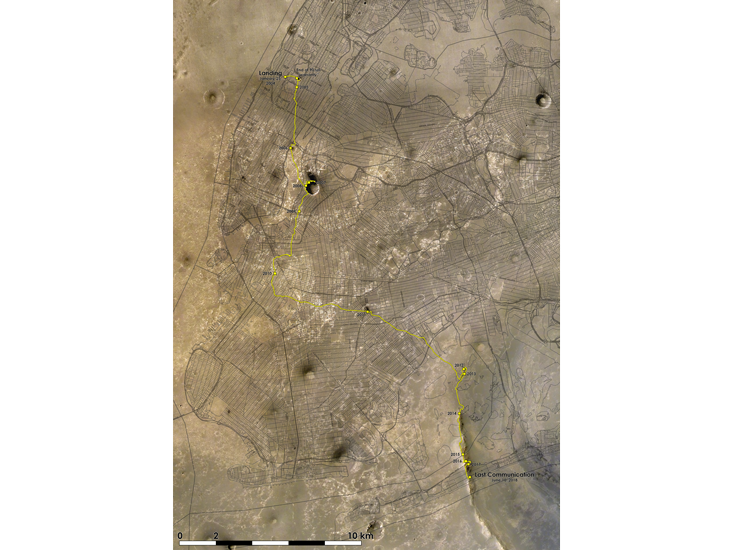For human travelers, the iconic moment of space exploration occurred a half-century ago, when Neil Armstrong planted the first human boot-print on the moon. But if you don’t mind using robots as our stand-ins, the greatest era is unfolding right now on Mars, where NASA’s Curiosity rover is rolling across the rusty, dusty surface and leaving behind tread marks that spell out the letters “J-P-L” in Morse code. JPL stands for the Jet Propulsion Laboratory, the NASA center that designed and built Curiosity along with three earlier Mars rovers. Collectively, these machines have racked up 46.4 miles of travel, tremendously expanded our understanding of the Martian environment, and energized the search for life in the universe.
Everywhere the rovers have gone, they have discovered unexpected complexity. They have observed the dried-out remains of streams, rivers, lakes, and catastrophic flows that testify to a time, more than 3.5 billion years ago, when Mars was abuzz with volcanic activity and luxuriously bathed in liquid water. They have found puzzling atmospheric changes that hint at some unknown chemical processes still unfolding today. And they see evidence that, if you scratch below the barren-looking Martian surface, there is a lively (maybe even living?) planet waiting to be discovered.

The Quick and the Dead
Most missions to Mars so far have been landers, rooted to one spot, and the majority of those (including every attempt by the Soviet Union) have ended in failure. Soundly beating those odds, all four NASA rovers have landed and operated successfully, though only Curiosity is still operational. By early next year, there could be three more rovers poking around on the planet: NASA’s Mars2020, the European Space Agency’s Rosalind Franklin (named after the co-discoverer of DNA’s double helix) and China’s Huoxing-1 (“Mars-1” in Mandarin).

Sojourner (July 4, 1997-Sept. 27, 1997)
The Mini Cooper of Mars rovers, the cute little Sojourner was NASA’s first Internet sensation when it touched down on the Red Planet. The six-wheeled rover weighed just 23 pounds and wore solar panels on its top for power. After rolling out of its parent spaceship, the Mars Pathfinder lander, Sojourner deployed a miniature weather station, scanned its surroundings with a stereo camera, and examined the composition of the rocks and soil. It racked up 80 million page views when it emerged on July 7, a smash success back in those innocent days when the web was in its infancy.
Sojourner established the template for much of the robotic Mars exploration that has followed. The map of its explorations is marked with dates noting the number of Sols, or Martian days, after landing. (Images from the Pathfinder landing station were stitched together to create this odd-looking panorama.) Each Mars day is 24 hours, 37 minutes long, forcing NASA’s Earthbound rover operators to adapt to Mars’s shifted day-night cycles, and the mission lasted much longer than projected: 83 days instead of the planned seven. And as with all of the Mars rovers, Sojourner was sent to a site that once had abundant water. Life on Earth needs water to survive, and the going assumption is that any life on Mars would operate the same way. After the Sojourner landing, NASA scientists coined a motto, “follow the water,” to guide their Mars investigations.
You wouldn’t know it by glancing around, but Sojourner’s landing site was once a vast flood plain, situated between two enormous river-like outflows called Ares and Tiu. Before the rover arrived, planetary scientists suspected that the water there resulted from a catastrophic flood billions of years ago. In the course of its short-distance excursions around its landing site, Sojourner found rounded rocks that imply the existence of running water over an extended period, perhaps part of a series of channels connecting an ancient ocean to an inland sea—good news in the ongoing search for Martian life.

Spirit (Jan. 4, 2004-March 22, 2010)
Now we’re cruising. Along with its identical twin, Opportunity, Spirit marked a major escalation in NASA’s robotic surveying of Mars. It carried a nuclear-powered heater to keep warm, allowing it to devote all the electricity from solar panels to scientific instruments and to performing some crazy six-wheeling on Mars. The mission planners designed it to last 90 days and travel at least 600 meters. The rover had logged 7.7 kilometers (4.8 miles) before getting trapped in sand on May 1, 2009, and it continued to operate in position for another year after that.
Spirit’s outing began with a landing in a crater called Gusev, which might have produced local flooding when the heat of an asteroid impact melted buried ice. It covered so much territory that team scientists had to keep coming up with names for local features so they could stay oriented. Many of those names, including Columbia Hills, were selected in memory of the Challenger space shuttle mission, which ended in disaster in 2003; some remain more informal. An outcropping called Home Plate got its name for the crashingly simple reason that it resembles a baseball home plate.
Over that long course, Spirit documented much more evidence of ancient running water—so much that it became a running joke among science journalists that every NASA press conference contained a new announcement of the “discovery” of water on Mars. Columbia Hills contained rocks that had evidently been altered by water, while Home Plate was dominated more by volcanic rocks. The specific spot where the rover got stuck—nicknamed Gertrude Weise, after a player in the All-American Girls Professional Baseball League—was covered in silica deposits that probably formed in the presence of hot springs. Spirit got trapped in direct evidence that Mars was once warm and wet.

Opportunity (Jan. 25, 2004-June 10, 2018)
Spirit’s twin landed three weeks later on the opposite side of Mars, and proceeded to set a still-unbroken long-distance driving record on another world. Over more than 14 years (60 times its designed lifetime), Opportunity covered 28.06 miles. To help visualize that distance, planetary geologist Justin Cowart of Stoney Brook University superimposed the rover’s path over a map of New York City. The 408-pound, nuclear-enhanced Opportunity covered the equivalent of a trip from Central Park to the Coney Island boardwalk. By comparison, the longest drive on the moon—performed by the Apollo 17 crew, using a vastly larger moon buggy—topped out at 22.2 miles.
Opportunity set down within a crater called Eagle, located a vast plain called Meridiani Planum, and quickly filled in many more details about long-lost water on Mars. For instance, the rover spotted small, bluish rock spheres, called “blueberries” because of their fruity appearance, that must have formed in the presence of pooled water. Like Spirit, Opportunity was equipped with a drilling tool and a microscopic camera to analyze rocks in detail. Combined with other data from its chemical sensors, the findings resoundingly confirmed that Mars once had a much thicker atmosphere and abundant water on its surface. “We think Opportunity is parked on what was once the shoreline of a salty sea on Mars,” said Steve Squires of Cornell University at the time.
The rover’s epic journey included a tour of Victoria Crater and an excursion to the outskirts of the enormous Endeavor Crater before it was finally felled by a global dust storm that cut off all the sunshine from its solar panels. It passed several meteorites on Mars, including a hunk of metal nicknamed Heat Shield Rock, showing how the planet has been bombarded by asteroids. You can’t fault the hardest-working rover in show business for failing to find any direct evidence of life during its explorations; in NASA’s conservative, methodical approach it was never intended to.

Curiosity (Aug. 6, 2012-present)
NASA’s latest, greatest rover builds on the lessons of all that came before. Compared to the dainty Sojourner, it’s a hulking Chevy Suburban, or maybe a Range Rover. Curiosity weighs in at 1,982 pounds, has an onboard nuclear generator for power, and bristles with 17 cameras, including a geology microscope and a remote-analysis telescope called ChemCam. It even shoots its own laser beams to vaporize rocks and examine their composition. Plus it’s decked out with those six JPL-imprinting wheels, each 20 inches wide.
With all that imagery flowing in, mission scientists have gone a little crazy giving names to every rock and feature that Curiosity has passed in the 13.4 miles it has traveled so far, as you can see from the map. Data gathered by the earlier missions also guided Curiosity’s landing site in Gale Crater, a 3.5-billion-year-old, 96-mile-wide impact site that was subsequently filled with wet sediment and dust, then eroded away. That unusual geological setting has allowed Curiosity to examine different eras of Martian history as it drives around the crater.
As an extraterrestrial geologist, Curiosity has been an unqualified success: touring eerie Martian sand dunes, documenting bizarre rock formations and mineral salts, and demonstrating that the region near its landing site was once the mouth of a river or else a lake that intermittently flooded and dried. In the ever-optimistic NASA manner, Curiosity’s project scientist, John Grotzinger, concluded that “conditions once were favorable for life” here. The rover has also discovered puzzling variations in oxygen and methane in the air, which could just maybe be signs of biological activity. But in the search for actual life or its remains, Curiosity has left things frustratingly inconclusive.
Fortunately, NASA’s next Mars rover (known as Mars2020 until the agency picks a real name) is intended to get down to business. It will come equipped with tools designed specifically to search for organic material: carbon-based compounds like those associated with biology. Finding organics alone would still not prove the existence of past or present life, so Mars2020 has another trick up its sleeve. It will put the most promising samples into storage tubes and hold them for a future mission to collect them and bring them back to Earth, where scientists can look for micro-fossils and perform far more sensitive chemical investigations. That final, 100-million-mile journey back home might be what it takes to finally answer the question of whether Mars is alive or dead.
Corey S. Powell is an Earth-based science writer and editor, and co-host of the Science Rules! podcast. He is a frequent presence on Twitter: @coreyspowell
Lead image: NASA/JPL-Caltech






























